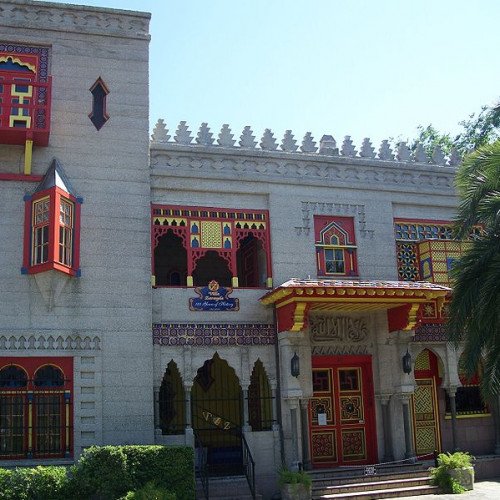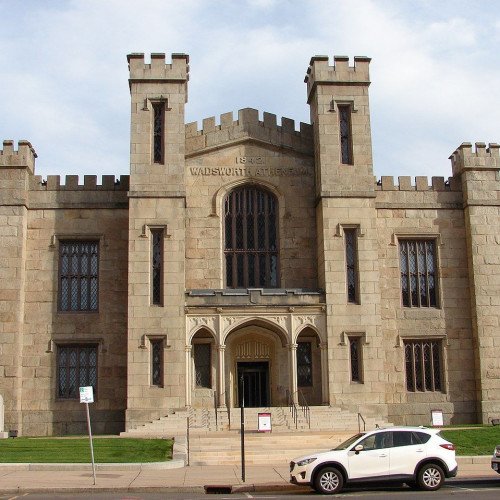Castles of "United States" VILLA ZORAYDA vs WADSWORTH ATHENEUM

VILLA ZORAYDA
Villa Zorayda (also known as the Zorayda Castle) is a house at 83 King Street in St. Augustine, Florida. Built in 1883 by the eccentric Boston millionaire Franklin W. Smith as his winter home, it was inspired by the 12th-century Moorish Alhambra Palace in Granada, Spain. Smith named it "Villa Zorayda", after one of the princesses in Washington Irving's Tales of the Alhambra. The building and part of Franklin Smith's art and antique collection were sold to Abraham Mussallem, a rug and antiquities merchant originally from Syria, in 1913. On September 23, 1993, it was added to the U.S. National Register of Historic Places. The Villa Zorayda Museum is still owned by the Mussallem family and contains the original art and antique collection assembled by Franklin Smith and Abraham Mussallem. Franklin W. Smith was an amateur architec and pioneer experimenter in poured concrete construction. His winter home, Villa Zorayda, was the first residence built in the Moorish Revival style in Florida, and the first poured concrete building in St. Augustine. Smith's concrete mix, which used crushed coquina shells as an aggregate, and his method of pouring it in successive levels, was adopted by Henry Morrison Flagler, a Standard Oil partner and Florida developer, for his nearby hotels and churches on an even grander scale. Villa Zorayda could also be considered the first example of fantasy architecture in Florida. Smith was an early member of the Republican Party, and danced with his wife at Abraham Lincoln's inaugural ball in 1861. He was also a founder of the Boston YMCA, and was involved in many reform efforts and schemes for public improvement in the course of his long life. He is buried in the Mount Auburn Cemetery in Cambridge, Massachusetts. One block east of Villa Zorayda is the largest building Smith constructed in St. Augustine, the Casa Monica Hotel (later purchased by Henry Flagler and renamed the Cordova Hotel).
Statistics for this Xoptio

WADSWORTH ATHENEUM
The Wadsworth Atheneum is an art museum in Hartford, Connecticut. The Wadsworth is noted for its collections of European Baroque art, ancient Egyptian and Classical bronzes, French and American Impressionist paintings, Hudson River School landscapes, modernist masterpieces and contemporary works, as well as collections of early American furniture and decorative arts. Founded in 1842 and opened in 1844, it is the oldest continually operating public art museum in the United States. The museum is located at 600 Main Street in a distinctive castle-like building in downtown Hartford, Connecticut, the state's capital. With 75,000 square feet (7,000 m2) of exhibition space, the museum is the largest art museum in the state of Connecticut. It was listed on the National Register of Historic Places in 1970. The museum is a member of the North American Reciprocal Museums program. The Wadsworth, as it is most commonly known, was constructed on the site of the family home of Daniel Wadsworth in the heart of downtown Hartford. Its architects were Alexander Jackson Davis and Ithiel Town, who designed the "castle" that is the Atheneum's oldest building. Construction began in 1842 after the museum was incorporated on June 1 of that year. The museum opened on July 31, 1844 and has operated continuously since then. The Wadsworth family, being one of the oldest and most affluent in the city, contributed numerous valuable pieces of art to be displayed at the time the museum opened. The first collection consisted of 78 paintings, two marble busts, one portrait miniature, and one bronze sculpture. In addition to the fine arts collection, the original building housed the forerunners of the Hartford Public Library and Connecticut Historical Society, giving rise to the name "Atheneum," an institution broadly devoted to culture and learning. In light of that public role, the Wadsworth has, since its founding, played host to a wide variety of cultural and community activities, including dramatic and dance performances, exhibits of historical artifacts, social functions, and benefits.